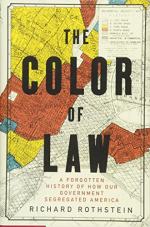
|
Preface and Chapter 1, If San Francisco, then Everywhere?, pages vii to 16
1. What turmoil does Rothstein say led him to consider writing this book?
(a) Los Angeles race riots.
(b) White supremacists’ murders of black people.
(c) Riots in Ferguson.
(d) Police killings of blacks in Baltimore.
2. What is de facto segregation?
(a) White supremacist threats keeping races apart.
(b) Private decisions keeping races apart.
(c) Geographical features keeping races apart.
(d) Government policies keeping races apart.
3. What is de jure segregation?
(a) Private decisions keeping races apart.
(b) White supremacist threats keeping races apart.
(c) Government policies keeping races apart.
(d) Geographical features keeping races apart.
4. What is redlining?
(a) Charging higher interest on a managing.
(b) Increasing the amount a family has to put down to get a mortgage.
(c) Refusing to offer mortgages to black families in certain areas.
(d) Placing neighborhoods next to industrial neighborhoods.
5. What does Rothstein say is the main point of his book?
(a) Rothstein says that he wants to make it clear that segregation was a deliberate policy of the U.S. government.
(b) Rothstein says he wants to show that segregation involved good people on both sides of the issue.
(c) Rothstein says he wanted to expose the details that reveal the inaccuracies at the heart of federal housing policy.
(d) Rothstein wanted to demonstrate how our current problems are rooted in historical trends.
(read all 180 Multiple Choice Questions and Answers)
|
This section contains 5,173 words (approx. 18 pages at 300 words per page) |

|




